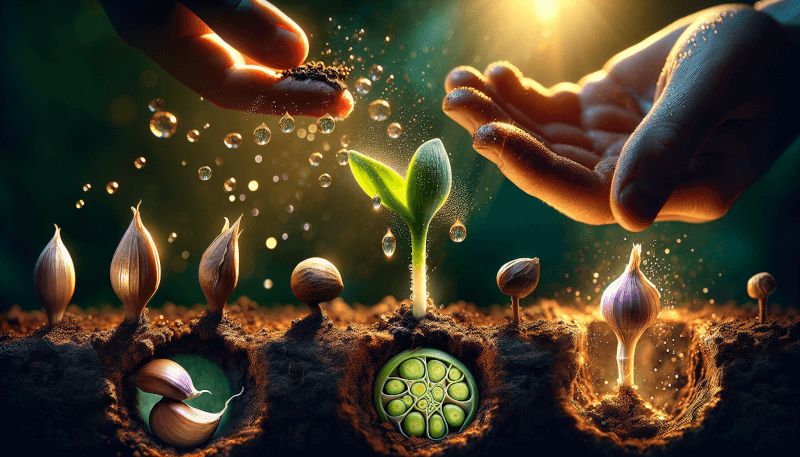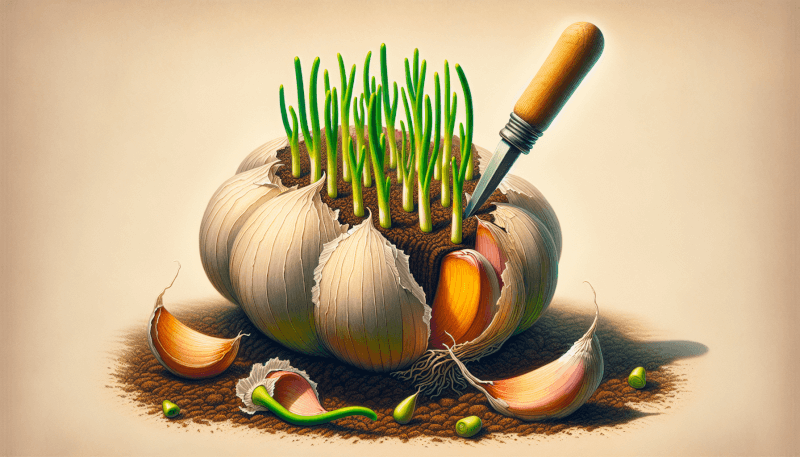If you’ve ever wanted to try your hand at growing your own garlic, you’re in luck! In this article, we’ll share some tips and tricks for successfully growing garlic seeds. From choosing the right seeds to preparing the soil, we’ll cover everything you need to know to ensure a bountiful harvest of aromatic and flavorful garlic. Whether you’re a seasoned gardener or a complete novice, get ready to embark on a gardening adventure that will leave your taste buds tingling with delight. Let’s get started!

Choosing Garlic Seeds
When it comes to growing garlic, selecting the right garlic variety is crucial. With so many different varieties available, each offering its own unique flavor and characteristics, it’s important to choose the one that best suits your preferences and growing conditions. Consider factors such as taste, bulb size, cloves per bulb, storability, and hardiness. Knowing the specific qualities you desire in garlic will help you narrow down your options and make an informed decision.
In addition to selecting the right garlic variety, it is equally important to choose high-quality seeds. This ensures that the seeds you plant will have the best chance of producing healthy, robust garlic plants. Look for firm, full cloves with no signs of damage or disease. Avoid anything that appears soft, moldy, or discolored. It’s also wise to source your garlic seeds from reputable suppliers or local farmers who specialize in garlic cultivation.
Another factor to consider when choosing garlic seeds is the distinction between hardneck and softneck garlic. Hardneck varieties produce a flower stalk or “scape” in the spring, while softneck varieties do not. Hardneck garlic typically has larger cloves, a more intense flavor, and is better suited for colder climates. On the other hand, softneck garlic is known for its longer storage life, milder taste, and ability to thrive in milder climates. Understanding the differences between these two types will help you determine which is best suited for your specific location and preferences.
Preparing the Soil
Preparing the soil properly is essential for growing healthy and vigorous garlic plants. Begin by testing the soil pH levels to ensure they fall within the optimal range of 6.0 to 7.0. This can be done with a simple soil test kit or by sending a soil sample to a local agricultural extension office for analysis. If the pH is too low or too high, you can adjust it by incorporating lime to raise the pH or sulfur to lower it.
Once the pH levels are in the appropriate range, it’s time to amend the soil with organic matter. Garlic thrives in well-draining soil with good fertility. Incorporate compost, well-rotted manure, or other organic materials into the soil to improve its structure, water-holding capacity, and nutrient content. This will create a fertile environment for the garlic plants to grow and develop.
Before planting garlic seeds, it’s essential to clear the soil of weeds and debris. Weeds compete with garlic plants for nutrients, water, and sunlight, so it’s important to remove them to prevent stunted growth and decreased yields. Remove any large stones, roots, or other debris that may hinder bulb development or impede the growth of the garlic plants.

Planting Garlic Seeds
Choosing the right time to plant garlic seeds is crucial for a successful harvest. Garlic is typically planted in the fall, a few weeks before the ground freezes, allowing the cloves to establish roots before winter. This timing allows the plants to benefit from the cool temperatures and dormant period during winter, resulting in bigger and healthier bulbs.
To get your garlic seeds ready for planting, separate the cloves from the bulb just before planting. Be sure to choose the largest, healthiest cloves for planting, as these will produce the best bulbs. Leave the papery skin intact on each clove to protect it during planting.
When it comes to planting depth, garlic cloves should be planted about two inches deep, with the pointed end facing up and the flat end down. This ensures that the shoots emerge from the correct end of the clove and allows for proper root development.
Proper spacing is also important for garlic plants. Space the cloves about six inches apart within rows, and leave around 12 inches between rows. This spacing allows the plants enough room to grow and develop without crowding each other.
Watering Garlic Seeds
Providing regular watering is essential to ensure the proper growth and development of garlic plants. During the initial planting phase, it’s crucial to keep the soil consistently moist but not waterlogged. Garlic prefers well-draining soil, so avoid overwatering, as this can lead to rot and other issues.
To monitor soil moisture, check the soil with your finger or use a moisture meter. Water the plants when the top one to two inches of soil feels dry. It’s important to water deeply, ensuring that the water reaches the root zone of the plants. This encourages deep root growth and helps the plants become more resilient to drought conditions.
During the growing season, garlic plants typically require around one inch of water per week. However, this may vary depending on your specific climate and soil conditions. Adjust your watering schedule accordingly, taking into account natural rainfall in your area.

Mulching Garlic Plants
Mulching is a beneficial practice for garlic plants, as it helps conserve moisture, suppress weeds, regulate soil temperature, and improve overall plant health. It also provides a protective layer that helps prevent the growth of fungal diseases.
When choosing the right mulch for garlic plants, opt for organic materials such as straw, hay, leaves, or grass clippings. These materials allow for proper air circulation and decompose over time, enriching the soil with organic matter.
Apply the mulch around the base of the garlic plants, making sure to cover the soil surface evenly. Aim for a layer of mulch about two to four inches deep. Be careful not to bury the garlic shoots, as this can hinder their growth. Leave a small space around each plant to allow for air circulation.
The benefits of mulching garlic plants are numerous. Mulch helps regulate soil temperature, keeping it cooler in the summer and warmer in the winter. This stability helps the plants thrive and reduces stress during extreme weather conditions. Additionally, mulch acts as a natural weed barrier, reducing weed competition and saving you precious time and effort spent on weeding.
Fertilizing Garlic Seeds
Understanding the nutrient requirements of garlic plants is vital for their optimal growth and development. Garlic is a heavy feeder and benefits from regular fertilization throughout the growing season.
Before planting garlic seeds, incorporate compost or organic fertilizer into the soil. This provides a nutrient-rich base for the plants and promotes healthy root development. Avoid using synthetic fertilizers, as they may contribute to nutrient imbalances and harm the soil microbiota.
Throughout the growing season, continue to feed garlic plants with organic fertilizers such as fish emulsion, kelp meal, or compost tea. These natural fertilizers provide a slow-release of nutrients and promote overall plant health. Apply the fertilizers according to the package instructions, adjusting the dosage based on the specific needs of your garlic plants.

Managing Weeds and Pests
Regular weeding is essential for garlic plants, as weeds can compete for vital resources and hinder the growth of your crop. Keep the area around your garlic plants clean and free from weeds by hand-pulling or using a garden hoe. Be careful not to damage the garlic bulbs or disturb the root system while weeding.
When it comes to pests, using organic pest control methods is recommended to protect your garlic plants without harming the environment. Neem oil, insecticidal soap, and homemade garlic or chili pepper sprays are effective natural alternatives to chemical pesticides. Monitor your plants regularly for signs of pests, and take action at the first sight of infestation.
Identifying common garlic pests and diseases is crucial for effective management. Common pests that affect garlic include aphids, thrips, onion maggots, and nematodes. Diseases such as white rot, garlic rust, and fusarium can also pose threats to your crop. Research and learn about the signs and symptoms of these issues to promptly address them and protect your plants.
Monitoring and Maintenance
Inspecting your garlic plants regularly is important for identifying any potential issues or abnormalities. Look for signs of pests, diseases, nutrient deficiencies or excesses, and any other factors that may affect the health of your plants. Early detection allows for timely intervention and helps prevent the spread of problems.
During the growing season, garlic plants will produce flower stalks called scapes. While scapes are edible and can be a culinary delight, their removal redirects the energy of the plant towards bulb development, resulting in larger and more flavorful garlic bulbs. Trim scapes when they form a loop or curl, and use them in various dishes for a delicious garlic flavor.
Additionally, keep an eye out for yellowed or damaged leaves on your garlic plants. Trim these leaves to redirect the plant’s energy towards healthy growth. Removing diseased or yellowed leaves also prevents the spread of diseases and ensures that the plant allocates its resources properly.
If necessary, support your garlic plants with stakes or cages to prevent them from toppling over. This is especially important for tall or heavy-headed varieties that may need some additional support to stay upright. Providing proper support helps prevent damage to the plants and ensures that the bulbs develop evenly.

Harvesting Garlic Seeds
Determining the right time to harvest your garlic bulbs is crucial for obtaining the best flavor and storage capabilities. Garlic is typically ready to harvest when the leaves start to yellow and dry out, usually in mid to late summer.
To harvest garlic bulbs, gently loosen the soil around them with a garden fork or trowel. Be careful not to damage the bulbs as you lift them from the ground. Shake off any excess soil and leave the garlic plants to dry in a cool, well-ventilated area for a few weeks.
Curing the garlic bulbs is an important step in the harvesting process. This allows the outer skins to dry and harden, enhancing their storage life. Hang the bulbs in bundles or spread them out in a single layer in a well-ventilated area away from direct sunlight and excessive moisture. After a few weeks, the bulbs should feel firm and have a papery skin.
Once the garlic bulbs are properly cured, they can be stored for future use. Remove any excess soil or loose outer skins, but leave the bulbs whole with the inner skins intact. Store the garlic in a cool, dark, and dry place with good air circulation, such as a mesh bag or a wire basket. Properly stored garlic bulbs can last for several months, providing you with a steady supply of fresh, homegrown garlic.
Saving Garlic Seeds for Next Season
If you want to save garlic seeds for the next growing season, it’s important to select the best garlic bulbs as seed stock. Choose bulbs that are large, healthy, and free from any signs of disease or damage. Avoid using bulbs that have started to sprout, as this may indicate decreased viability.
Before storing the garlic bulbs for seed use, prepare them by separating the cloves and leaving the papery skins intact. Store the cloves in a cool, dark, and dry place, such as a paper bag or a mesh bag, until planting time in the fall.
When the planting season arrives, choose the best cloves from your stored garlic bulbs for planting. These cloves will serve as your seed stock for the new crop. Ensure that the cloves are firm and healthy before planting them in well-prepared soil following the same guidelines mentioned earlier.
By saving garlic seeds from your own crop, you can maintain the desired characteristics of your chosen garlic variety and continue to enjoy its unique flavor and qualities season after season.
In conclusion, growing garlic seeds requires careful attention to detail and proper maintenance throughout the entire process. From choosing the right garlic variety to harvesting and storing the bulbs, each step plays a crucial role in the success of your garlic crop. By following these guidelines and dedicating a little time and effort, you can enjoy the satisfaction of growing your own flavorful garlic at home. Happy garlic gardening!

